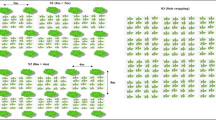Abstract
In southern Benin, West Africa, two alley cropping systems were studied from 1986 to 1992. Yield development was followed in a maize and cassava crop rotation vs. intercropping system, with alleys of Leucaena leucocephala (Lam.) de Wit and Cajanus cajan (L.) Millsp. vs. a no-tree control, with and without NPK fertiliser. Without alleys, NPK fertilisation maintained high yield levels of 2–3 t maize dry grain plus 4–6 t ha−1 cassava root DM in intercropping, 3–4 t ha−1 maize and 6–10 t ha−1 cassava in solercropping. Without NPK, final yields seemed to stabilise at about 1 t maize plus 2 t cassava in intercropping and twice as much in each solecrop. Alley cropping induced significant yield increases by about 50% with both tree species in unfertilised, intercropped maize, and with Cajanus in fertilised, solecropped cassava. In monetary terms, the NPK-fertiliser response of stabilised yields was significant for all treatments except the solecropped Leucaena alleys. It is concluded that on Ultisols with low nutrient status in the upper rooting zone, alley cropping with low-competitive tree species may improve food crop yields but the greatest monetary output is achieved by intercropping with mineral fertiliser independent of the presence or absence of an agroforestry component.
Similar content being viewed by others
References
Akondé TP, Kühne RF, Leihner DE and Steinmüller N (1996) Alley cropping on an Ultisol in subhumid Benin, Part 3: Nutrient budget of maize, cassava and trees. Agrofor Syst (submitted)
Browers JHAM (1993) Rural People's Response to Soil Fertility Decline. The Adja Case (Benin). Veenmann Drukkers, Wageningen, The Netherlands
Dörfel H and Bauer T (1991) Planung und Auswertung der dreifaktoriellen Streifenspaltanlage (A + B)/C — B1 und der Spaltstreifenanlage A/ (B+C) — B1. Biometr Informatik Med Biol 22(2): 48–57
Ezumah HC (1990) Maize (Zea mays) genotypes for intercropping with cassava (Manihot esculenta) in Southern Nigeria. 1. Yield responses. Discovery Innovation 2(2): 63–72
Fagla P (1971–74) Action de développement (recherche et expérimentation) de la culture cotonniére dans le Sud-Dahomey. Rapport annuel 1971–72, 1972 and 1974. Institut de Recherches du Coton et Textiles Exotiques, Cotonou, République du Dahomey
Fagla 1977 Rapport annuel 1977, Province du Zou et provinces côtiféres. Direction de la Recherche Agronomique, Recherche Coton et Fibres, Cotonou, république Populaire du Benin
Gaborel P (1989) Rapport de Campagne 1988–89. Direction de la Recherche Agronomique, Recherche Coton et Fibres, Cotonou, République Populaire du Benin
Gaiser (1993) Bedeutung der organischen Bodensubstanz für Eigenschaften und Ertragsfähigkeit von Vertisolen und Acrisolen in Süd-Benin. Hohenheimer Bodenkundliche Hefte, Heft 12. Institut für Bodenkunde, Universität Hohenheim, Germany, 168 pp
Hauser S (1993) Root distribution of Dactyladenia (Acioa) barteri and Senna (Cassia) siamea in alley cropping on Ultisol. I. Implication for yield experimentation. Agrofor Syst 24: 111–121
Horst WJ (1992) Cropping systems and their effect on sustained soil productivity in the tropics. In: Seifert SHS, Vlek PLG and Weidelt HJ (eds) Göttinger Beiträge zur Land- und Forstwirtschaft, Heft 71, pp 243–268. Verlag Erich Goltze, Göttingen, Germany
Howeler RH and Cadavid LF (1990) Short- and long-term fertility trials in Colombia to determine the nutrient requirements of cassava. Fert Res 26: 61–80
Kühne RF (1993) Wasser-und Nährstoffhaushalt in Mais-Maniok-Anbausystemen mit und ohne Integration von Alleekulturen (‘Alley cropping’) in Süd-Benin. Hohenheimer Bodenkundliche Hefte, Heft 13. Hohenheim University, Stuttgart, Germany, 244 pp
Leihner DE, Ernst-Schaeben R, Akondé TP and Steinmüller N (1996) Alley cropping on an Ultisol in subhumid Benin. Part 2: Changes in crop physiology and tree crop competition. Agrofor Syst 34: 13–25
Ong CK (1994) Alley cropping — ecological pie in the sky? Agrofor Today 6(3): 8–10
Röckel H (1991) Wurzelwachstum der Komponenten eines Alley-Cropping-Anbausystems im Süden Benins. MSc Thesis. Inst of Plant Nutrition, Univ of Hannover, Germany
Sanchez PA, Bandy DE, Villachica JH and Nicholaides JJ (1982) Amazonas basin soils: Management for continuous crop production. Science 216: 821–827
SAS (1990) SAS/STAT User's Guide, version 6, 4th ed, Vol 2. SAS Inst Inc, Cary, NC
Schlauderer R (1996) Socio-economics of the Introduction of Alley Cropping in Traditional Farming System. PhD Thesis. Hohenheim University, Stuttgart, Germany (in preparation)
Sonnemann, E (1982) Allgemeine Lösungen multipler Testprobleme. EDV in Medizin Biologie 13: 120–128
Author information
Authors and Affiliations
Rights and permissions
About this article
Cite this article
Akondé, T.P., Leihner, D.E. & Steinmüller, N. Alley cropping on an Ultisol in subhumid Benin. Part 1: Long-term effect on maize, cassava and tree productivity. Agroforest Syst 34, 1–12 (1996). https://doi.org/10.1007/BF00129628
Issue Date:
DOI: https://doi.org/10.1007/BF00129628




